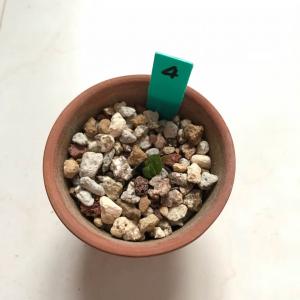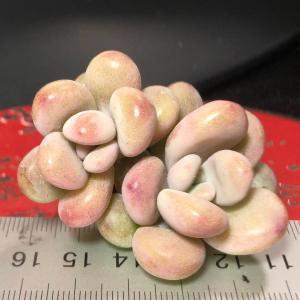文章
权问薇
2018年02月04日


一、施肥的时间
众所周知,在每年九月到次年4到5月的这段时间,就是它的生长期,这时候肯定需要的肥量是很多的,所以这时候我们在施肥的时候,可以适当的多给它施加一点,从而给它提供充足的营养,让它更好的生长。
但是等过了中秋之后,这时候温度慢慢降了下来,如果要施肥的话就不能那么随心所欲了,我们为了让它能够平安的迎接冬天并顺利越冬,就必须要停止施加任何肥料了,以防给它带来肥。因为这时候温度很低,施肥太多会容易伤到它的根。
然后等到了春天就可以正常施肥了,另外到了夏天也要注意,尤其是高温时,施肥也是要适当减少的,以防高温给根带来伤害。

二、肥料的选择
在刚开始栽培它的时候,我们应该在基质中加入一些复合肥,以满足它前期所需,然后等到了生长期之后,每个月可以给它施加一次稀薄的液态肥料。接着等到了秋天之后,就可以追施一点磷酸二氢钾,浓度要掌握好,就这样施加个2到3次,便可以让它叶片更加硬化和充实。
之后在每年给钱串换盆的时候,我们可以在它的盆底加入一下长效基肥,这样就可以长时间的给它提供营养。
然后在平时养护时,还需施加少量的复合肥,这种肥料的肥效非常快,使用也很方便,而且在施加之后会让养分更多,但是要注意的是,施加的量要合理一点。

三、其他的注意事项
在平时施肥的时候,一定要注意不能让肥料撒到叶子上面,或者直接埋到根上,不然就会让叶子黄化、根系腐烂,严重的时候还会让整个植株死掉。
所以在施肥时,一旦发现肥料撒在叶子上,就要及时的给它抖落掉,或者是擦掉,对于根也是,在施肥时,尽可能让肥料离根远一点。

0
1
文章
Miss Chen
2018年02月03日

Description: This perennial plant is about 2-3' tall while in flower. There is a rosette of basal leaves up to 6" long and 4" wide on long petioles. They are medium green, sandpapery in texture, coarsely serrated along the margins, and broadly lanceolate, ovate, or cordate. From the middle of this rosette, a stout flowering stalk develops, which has smaller alternate leaves on short petioles. Usually there are erect side stems that each develop an inflorescence. An inflorescence consists of flat-headed clusters of small white flowerheads; usually, there are several of them bunched loosely together on the same plant. Each flowerhead is about 1/3" (8 mm.) across, consisting primarily of numerous disk florets, while the few ray florets are greatly reduced in size and barely perceptible. The overall effect is similar to a head of cauliflower. The blooming period occurs from late spring to mid-summer, and lasts about 2 months. There is no noticeable floral scent. Eventually, the flowerheads turn brown, and the achenes develop without tufts of hair. The central taproot is quite thickened and somewhat tuberous in appearance, while rhizomes promote the vegetative spread of this plant.
Cultivation: The preference is full sun and mesic conditions. However, a small amount of shade is tolerated, and the soil can vary from moist to slightly dry. A fertile loamy soil is preferred, although the presence of some sand or rocky material is tolerated. While established plants are fairly easy to grow, recent transplants can be temperamental. It is important to put the transplants into the ground after danger of hard frost has passed, but before the period of active growth occurs during the late spring and early summer. Foliar disease isn't a significant problem. During a drought, some of the lower leaves may turn yellow and wither away.
Range & Habitat: The native Wild Quinine occurs occasionally in the majority of counties in Illinois, however it is uncommon or absent in many areas of western and SE Illinois (see Distribution Map). In high quality habitats, Wild Quinine can be locally common, while in disturbed areas it is uncommon, possibly because of the limited dispersion of its seeds. Habitats include mesic black soil prairies, sand prairies, openings in rocky upland forests, savannas, scrubby barrens, limestone glades, and thickets.

Faunal Associations: The flowers attract Halictine bees, wasps, flies, beetles, and plant bugs. The beetles usually feed on pollen, while the other insects seek nectar primarily. The fly visitors include Syrphid flies, Tachinid flies, Flesh flies, Muscid flies, Anthomyiid flies, and others. Wasp visitors include Crabronine wasps, Eumenine wasps, Cuckoo wasps, Braconid wasps, and others. Mammalian herbivores appear to ignore this plant as a food source because the leaves are sandpapery in texture and bitter-tasting.
Photographic Location: The photographs were taken at a remnant prairie along an abandoned railroad in Champaign County, Illinois, and the webmaster's wildflower garden in Urbana, Illinois.

Comments: Don't be put off by the lack of conspicuous ray florets on the flowerheads – they are still quite showy, resembling small white pearls from a distance. The leaves are admittedly rather coarse, but they possess characteristics that help this plant to survive in the prairie (as well as one's flower garden). Because of the unique flowerheads, this plant can be confused with no other species in Illinois; there are some close relatives that occur in other states, however. Wild Quinine was used as a substitute for the bark of the Cinchona tree during World War I, when the supply of the latter was disrupted; this was an attempt to maintain the supply of quinine to treat malaria.
Cultivation: The preference is full sun and mesic conditions. However, a small amount of shade is tolerated, and the soil can vary from moist to slightly dry. A fertile loamy soil is preferred, although the presence of some sand or rocky material is tolerated. While established plants are fairly easy to grow, recent transplants can be temperamental. It is important to put the transplants into the ground after danger of hard frost has passed, but before the period of active growth occurs during the late spring and early summer. Foliar disease isn't a significant problem. During a drought, some of the lower leaves may turn yellow and wither away.
Range & Habitat: The native Wild Quinine occurs occasionally in the majority of counties in Illinois, however it is uncommon or absent in many areas of western and SE Illinois (see Distribution Map). In high quality habitats, Wild Quinine can be locally common, while in disturbed areas it is uncommon, possibly because of the limited dispersion of its seeds. Habitats include mesic black soil prairies, sand prairies, openings in rocky upland forests, savannas, scrubby barrens, limestone glades, and thickets.

Faunal Associations: The flowers attract Halictine bees, wasps, flies, beetles, and plant bugs. The beetles usually feed on pollen, while the other insects seek nectar primarily. The fly visitors include Syrphid flies, Tachinid flies, Flesh flies, Muscid flies, Anthomyiid flies, and others. Wasp visitors include Crabronine wasps, Eumenine wasps, Cuckoo wasps, Braconid wasps, and others. Mammalian herbivores appear to ignore this plant as a food source because the leaves are sandpapery in texture and bitter-tasting.
Photographic Location: The photographs were taken at a remnant prairie along an abandoned railroad in Champaign County, Illinois, and the webmaster's wildflower garden in Urbana, Illinois.

Comments: Don't be put off by the lack of conspicuous ray florets on the flowerheads – they are still quite showy, resembling small white pearls from a distance. The leaves are admittedly rather coarse, but they possess characteristics that help this plant to survive in the prairie (as well as one's flower garden). Because of the unique flowerheads, this plant can be confused with no other species in Illinois; there are some close relatives that occur in other states, however. Wild Quinine was used as a substitute for the bark of the Cinchona tree during World War I, when the supply of the latter was disrupted; this was an attempt to maintain the supply of quinine to treat malaria.
0
0
文章
权问薇
2018年02月03日


君子兰冻一冻,春天开花100朵!
君子兰养4-5年,或者长到12片叶片,才可以开花。但有的花友,这两个条件都满足了,为什么还是不开花呢?有可能是因为养护温度太高,君子兰无法春化长出花箭!

君子兰促花措施:
1.适当的低温。
适当低温有利于君子兰抽花箭,所以,冬天君子兰的养护温度不要超过15度,超过15度不容易春化长花箭,这就是广东等地君子兰很少开花的原因。

2.营造大温差。
大温差有利于君子兰花箭,5-15度之间最佳,最好不要低于5度,低于5度君子兰容易冻伤。
3.增施磷钾肥。
君子兰春天开花需要大量养分,所以冬天要给它适当补充磷钾肥,大家可以在盆沿挖2个小洞,撒一点点骨粉。或浇水时,加点磷酸二氢钾!
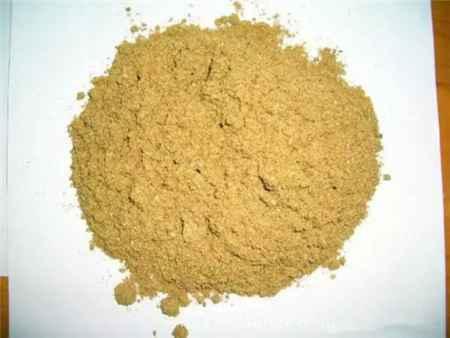
4.控制浇水。
君子兰在5-15度的低温环境下,需要控制浇水不然容易冻伤,大概1月浇1-2次即可,中午温度高的时候浇。

蝴蝶兰冻一下,花朵开成串!
快过年了,市场上的蝴蝶兰越来越多,开花后摆家里2-3个月都不谢,特别喜庆,那怎么让蝴蝶兰猛蹿花箭,开花多多呢?答案就是“折磨”它一下!

蝴蝶兰促花措施:
1.大温差折磨。
蝴蝶兰开花也需要一定的大温差刺激,晚上可以放冰箱冷藏,设置温度在8-10度左右,白天则拿出来放暖气房,温度20-25度左右,这样一天的总温差超过10度,持续6-8个星期,就能长出花箭了!

2.长花梗后提升温度。
长出花梗后,就把蝴蝶兰一直放在暖气房,保证温度22-30度之间,促进花梗继续生长,不需要再营造大温差!
3.增加光照时间。
蝴蝶兰长出花梗前后,都要放南阳台等光照充足的地方,使劲晒太阳,晒太阳越多,花梗越多,花朵也越多!

4.增施磷钾肥。
想要蝴蝶兰开花,开花前包括长出花梗时期,都要施磷钾肥,可以施复合肥,也可以施磷酸二氢钾,大概1个月2-3次即可,薄肥勤施,开花后不要施了。
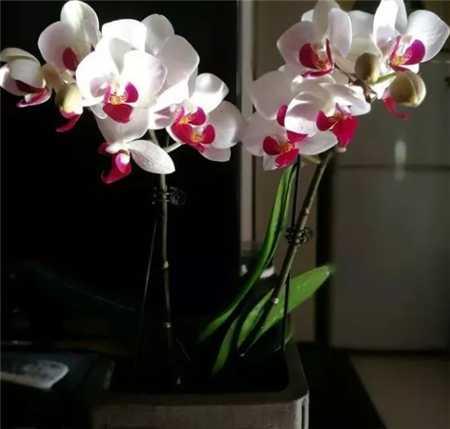
5.提高湿度。
蝴蝶兰喜湿,催花期间要保证较大的空气湿度,才有利于花梗生长,可以往蝴蝶兰叶片上多喷水,也可以在它周围放几个盛水的托盘增湿。

栀子花冻一冻,来年花朵压弯枝!
栀子在北方是很难养的,经常黄叶,而且很难养开花。但有时候我们不要它娇惯它,让它冬天挨挨冻,明年会开花更多哦!

栀子花促花措施:
1.适当低温使其休眠。
栀子花冬天最佳温度是0-12度,这个温度栀子花休眠而且不会冻伤,如果高于12度,则会发芽,消耗过多养分,导致明年开花少或者不开花。

2.控制浇水预防冻伤。
休眠期间的栀子花,新陈代谢缓慢吸收能力减弱,所以要控制浇水,以防积水烂根和冻伤,盆面发白特别干才能浇,大概1个月2次左右即可,中午浇。
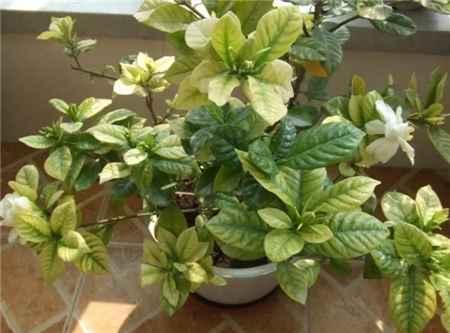
3.控制不要修剪储存养分。
栀子花休眠之前和休眠过程中,不要进行太多修剪活动,尽量保留较多的健康叶片,多晒太阳进行光合作用,积累足够多的养分利于越冬,清明节再重剪。

除了以上3种花,
像兰花、月季、茉莉等花卉,
冬天也需要一段时间的低温才能孕育花蕾,
大家不要一味得给花保温,
有时候适当的风雪会让它更坚强、更漂亮哦!
0
2
文章
权问薇
2018年02月02日


1、扦插的时间
在扦插的时候,首先要把时间确定好,如果你是用硬枝去扦插的话,时间一般就是在3到4月之间最好,如果你是用它的嫩枝去扦插的话,时间就是在6到7月之间最好了。由此看来扦插的时间是按照你用的插条决定的。

2、扦插的基质
在扦插之前,我们要先把基质给准备好,适合的基质会更加利于它的成活。一般来讲,六月雪对基质的要求并不怎么严格,但是用腐殖土和河沙混合在一起最好,这样才能满足它最基本的生长需求。基质配置好之后,我们把它放在水泥地上晒上1到2天,这样就给基质起到一个很好的杀毒作用,防止里面存有病虫害给植株带来影响。基质晒好了之后,我们就可以将它装到容器里面去等待扦插了。

3、扦插
我们先找来一棵较为健壮的母株,然后从它的上面剪下来一段6到8厘米长的插穗,之后等到切口处的伤口晾干之后,我们就可以将它插在准备好的基质里面了,插的时候,要注意插条插进去的深度,不可太深也不可以太浅了,适中就行。之后就可以等待插条生根了。另外如果有的人嫌麻烦,我们可以多剪取一些插条,然后合并在一起扦插在基质里面,这样等到10到11月的时候就可以给它们上盆了。

4、扦插之后的养护
扦插结束之后,后期的养护也是很重要的。初期的时候,插条是很害怕受到太阳照射的,所以我们就要及时的给它搭棚遮阴,然后还要注意浇水,让基质时刻是湿润的,这样子才能让插条更容易成活。等到插条成活之后,就可以让它正常的享受一些光照了,但是要注意光线不能太强了。
0
0
文章
Miss Chen
2018年02月02日

Description: This perennial wildflower consists of a small rosette of basal leaves spanning 2-4" across, from which there develops a single stalk of flowerheads about 6-14" tall. The basal leaves are 1½-3" long and ½-¾" across (at least twice as long as across); they are oblong-elliptic to oblong-lanceolate in shape and crenate-serrate along their margins. The teeth along the margins have blunt tips and they vary in size from large and coarse to small and fine. The upper and lower surfaces of the basal leaves are medium green and glabrous (or nearly so); young basal leaves are sometimes sparsely hairy or white-mealy. The petioles of the basal leaves are about one-half the length of the blades and relatively narrow; they are light green to pale purple and glabrous. The central stalk is light green to purple and glabrous (or nearly so); sometimes it has sparse cobwebby hairs toward the bottom. Along this stalk, there are 2-4 alternate leaves; they are up to 2½" long and ½" across, becoming smaller as they ascend the stalk. The alternate leaves are narrowly lanceolate-oblong, pinnatifid with cleft lobes, and/or coarsely dentate along their margins; they are sessile. The upper and lower surfaces of the alternate leaves are medium green and glabrous.
The central stalk terminates in a flat-headed panicle of 5-30 flowerheads. Each daisy-like flowerhead spans about ½-¾" across, consisting of 40 or more disk florets and 8-13 ray florets (rarely none); the disk and ray florets are both perfect and fertile. The corollas of the disk florets are deep golden yellow, cylindrical in shape, and 5-lobed. The petaloid extensions of the ray florets are yellow and linear-oblong in shape. Around the base of each flowerhead, there are several phyllaries (floral bracts) in a single series; they are about ¼" long. These phyllaries are linear in shape, glabrous, and mostly light green, except toward their tips, where they become pale purple. The branches and peduncles of the inflorescence are light green to pale purple and glabrous; there are often tiny bractlets where they diverge. These bractlets are scale-like and purple. The blooming period occurs from mid-spring to early summer, lasting about 3 weeks. Afterwards, the florets are replaced by small achenes with sessile tufts of white hair. These achenes are 1-2 mm. long and bullet-shaped. The root system consists of a short crown of fibrous roots and occasional rhizomes or stolons. Occasionally, clonal colonies of plants are produced from the rhizomes or stolons.
Cultivation: The preference is full or partial sun, moist conditions, and soil containing loam, sandy loam, or rocky material. Most growth and development occurs during the spring. The basal leaves persist throughout the warmer months into winter.

Range & Habitat: The native Balsam Ragwort is occasional in the northern half of Illinois, becoming rare or absent in the southern half of the state (see Distribution Map). Habitats include moist sand prairies, prairie remnants along railroads, sedge meadows, streambanks, moist sandy savannas, open woodlands, and abandoned fields. Areas with low ground vegetation and some history of disturbance are preferred.
Faunal Associations: The nectar and pollen of the flowerheads attract a variety of small to medium-sized insects, including cuckoo bees (Nomada spp.), Halictid bees, Andrenid bees, Syrphid flies, small butterflies and skippers, and miscellaneous beetles. An Andrenid bee, Andrena gardineri, is a specialist pollinator (oligolege) of Packera spp. (ragworts). Some insects feed on the foliage or seeds of ragworts. These species include caterpillars of the moth Agonopterix canadensis (Canadian Agonopterix) and the seed bug Neacoryphus bicrucis. The foliage of ragworts is toxic to most mammalian herbivores, causing liver damage.
Photographic Location: Along a bike path through a sand prairie at the Indiana Dunes National Lakeshore in NW Indiana.

Comments: As compared to the similar Prairie Ragwort (Packera plattensis), this ragwort prefers habitats that are more moist. Balsam Ragwort differs from the former species by its glabrous foliage and more narrow basal leaves. The basal leaves of other perennial ragworts (Packera spp.) in Illinois have basal leaves that are more broad. However, across its range, Balsam Ragwort is rather variable, possibly because of hybridization with similar species. The perennial ragworts in Illinois all bloom during the spring or early summer and they have showy yellow flowerheads. The annual and biennial ragworts in Illinois are mostly from Eurasia and they have less showy flowerheads. An exception is the native Butterweed (Packera glabella). This latter species is usually taller than the perennial ragworts and it lacks their conspicuous basal leaves during the blooming period. A scientific synonym of Balsam Ragwort is Senecio pauperculus; another common name of this species is Northern Ragwort.
The central stalk terminates in a flat-headed panicle of 5-30 flowerheads. Each daisy-like flowerhead spans about ½-¾" across, consisting of 40 or more disk florets and 8-13 ray florets (rarely none); the disk and ray florets are both perfect and fertile. The corollas of the disk florets are deep golden yellow, cylindrical in shape, and 5-lobed. The petaloid extensions of the ray florets are yellow and linear-oblong in shape. Around the base of each flowerhead, there are several phyllaries (floral bracts) in a single series; they are about ¼" long. These phyllaries are linear in shape, glabrous, and mostly light green, except toward their tips, where they become pale purple. The branches and peduncles of the inflorescence are light green to pale purple and glabrous; there are often tiny bractlets where they diverge. These bractlets are scale-like and purple. The blooming period occurs from mid-spring to early summer, lasting about 3 weeks. Afterwards, the florets are replaced by small achenes with sessile tufts of white hair. These achenes are 1-2 mm. long and bullet-shaped. The root system consists of a short crown of fibrous roots and occasional rhizomes or stolons. Occasionally, clonal colonies of plants are produced from the rhizomes or stolons.
Cultivation: The preference is full or partial sun, moist conditions, and soil containing loam, sandy loam, or rocky material. Most growth and development occurs during the spring. The basal leaves persist throughout the warmer months into winter.

Range & Habitat: The native Balsam Ragwort is occasional in the northern half of Illinois, becoming rare or absent in the southern half of the state (see Distribution Map). Habitats include moist sand prairies, prairie remnants along railroads, sedge meadows, streambanks, moist sandy savannas, open woodlands, and abandoned fields. Areas with low ground vegetation and some history of disturbance are preferred.
Faunal Associations: The nectar and pollen of the flowerheads attract a variety of small to medium-sized insects, including cuckoo bees (Nomada spp.), Halictid bees, Andrenid bees, Syrphid flies, small butterflies and skippers, and miscellaneous beetles. An Andrenid bee, Andrena gardineri, is a specialist pollinator (oligolege) of Packera spp. (ragworts). Some insects feed on the foliage or seeds of ragworts. These species include caterpillars of the moth Agonopterix canadensis (Canadian Agonopterix) and the seed bug Neacoryphus bicrucis. The foliage of ragworts is toxic to most mammalian herbivores, causing liver damage.
Photographic Location: Along a bike path through a sand prairie at the Indiana Dunes National Lakeshore in NW Indiana.

Comments: As compared to the similar Prairie Ragwort (Packera plattensis), this ragwort prefers habitats that are more moist. Balsam Ragwort differs from the former species by its glabrous foliage and more narrow basal leaves. The basal leaves of other perennial ragworts (Packera spp.) in Illinois have basal leaves that are more broad. However, across its range, Balsam Ragwort is rather variable, possibly because of hybridization with similar species. The perennial ragworts in Illinois all bloom during the spring or early summer and they have showy yellow flowerheads. The annual and biennial ragworts in Illinois are mostly from Eurasia and they have less showy flowerheads. An exception is the native Butterweed (Packera glabella). This latter species is usually taller than the perennial ragworts and it lacks their conspicuous basal leaves during the blooming period. A scientific synonym of Balsam Ragwort is Senecio pauperculus; another common name of this species is Northern Ragwort.
0
0
文章
Miss Chen
2018年02月02日

Description: This perennial plant is up to 6" tall. It consists of a small cluster of trifoliate basal leaves on long petioles that emerge directly from the ground. The petioles of the basal leaves are up to 4" long; they are whitish green to pale reddish green, terete, glabrous, and rather delicate in appearance. Individual trifoliate leaves are about 1" across and they open up during the day. Each leaf consists of three obcordate leaflets with smooth margins. The leaves may turn purplish in response to cold weather or strong sunlight, otherwise, they tend to be greyish green. Both the upper and lower leaflet surfaces are hairless.
Close-up of Flower
Among these leaves, floppy umbels of flowers develop on peduncles up to 6" long. The peduncles are similar in appearance to the petioles. Each umbel has 2-5 flowers on slender pedicels up to 1" long; usually only 1-2 flowers per umbel are in bloom at the same time. The flowers are bell-shaped (campanulate) and about 1/3" (8 mm.) across. Each flower has 5 lavender or pale purple petals, 5 light green sepals, 5 inserted stamens with yellow anthers, and an ovary with an inserted style. Near the throat of the flower, the petals become greenish white with converging fine veins; they are oblanceolate in shape, often becoming slightly recurved toward their tips. The sepals are shorter than the petals; they are lanceolate in shape and hairless with purplish tips. The blooming period occurs from mid-spring to early summer, lasting about 1-2 months. On rare occasions, Violet Wood Sorrel may bloom again during the fall. There is no floral scent. Eventually, slender pointed seed capsules develop that split into 5 sections, sometimes ejecting the light brown seeds several inches. The root system consists of small bulblets with fibrous roots; these bulblets can multiply by forming clonal offsets.
Cultivation: The preference is full to partial sun and mesic to dry conditions. The soil can be rocky or loamy. Disease is not normally a problem as long as the site is well-drained. Violet Wood Sorrel can be cultivated in gardens if taller and more aggressive vegetation is kept away.

Range & Habitat: The native Violet Wood Sorrel occurs in every county of Illinois (see Distribution Map). It is occasional throughout the state. Habitats include mesic to dry black soil prairies, hill prairies, open upland forests, savannas, edges of wooded bluffs, limestone glades, and abandoned fields. Violet Wood Sorrel responds positively to prairie wildfires as this clears away the dead vegetation that can smother this plant during the spring. It is usually found in higher quality natural areas where the original ground flora has been left intact.
Faunal Associations: Primarily long-tongued and short-tongued bees visit the flowers for nectar or pollen. This includes little carpenter bees (Ceratina spp.), cuckoo bees (Nomada spp.), mason bees (Osmia spp., Hoplitis spp.), Andrenid bees, and Halictid bees (including green metallic bees). Less commonly, the flowers may be visited by small butterflies, skippers, and bee flies. Syrphid flies also visit the flowers, but they feed on the pollen and are non-pollinating. The oligophagous caterpillars of a brownish Noctuid moth, Galgula partita (The Wedgling), feed on the leaflets of Oxalis spp. The seeds of Oxalis spp. are eaten to a limited extent by several upland gamebirds and songbirds, including the Bobwhite, Mourning Dove, Horned Lark, Field Sparrow, Grasshopper Sparrow, Savannah Sparrow, and Slate-Colored Junco. The Prairie Deer Mouse and White-Footed Mouse also eat the seeds of these plants. The Cottontail Rabbit browses on the foliage occasionally, even though it is mildly toxic because of the presence of oxalic acid.

Photographic Location: The photographs were taken at Loda Cemetery Prairie in Iroquois County, Illinois.
Comments: In Illinois, this is the only Oxalis sp. (Wood Sorrel) that has lavender or pale purple flowers. Other Wood Sorrel species within the state have yellow flowers. Both the flowers and leaves open up on sunny days, otherwise they fold up and "go to sleep." Violet Wood Sorrel is an attractive plant, although rather small in size. The leaflets are supposed to be edible in small amounts.
Close-up of Flower
Among these leaves, floppy umbels of flowers develop on peduncles up to 6" long. The peduncles are similar in appearance to the petioles. Each umbel has 2-5 flowers on slender pedicels up to 1" long; usually only 1-2 flowers per umbel are in bloom at the same time. The flowers are bell-shaped (campanulate) and about 1/3" (8 mm.) across. Each flower has 5 lavender or pale purple petals, 5 light green sepals, 5 inserted stamens with yellow anthers, and an ovary with an inserted style. Near the throat of the flower, the petals become greenish white with converging fine veins; they are oblanceolate in shape, often becoming slightly recurved toward their tips. The sepals are shorter than the petals; they are lanceolate in shape and hairless with purplish tips. The blooming period occurs from mid-spring to early summer, lasting about 1-2 months. On rare occasions, Violet Wood Sorrel may bloom again during the fall. There is no floral scent. Eventually, slender pointed seed capsules develop that split into 5 sections, sometimes ejecting the light brown seeds several inches. The root system consists of small bulblets with fibrous roots; these bulblets can multiply by forming clonal offsets.
Cultivation: The preference is full to partial sun and mesic to dry conditions. The soil can be rocky or loamy. Disease is not normally a problem as long as the site is well-drained. Violet Wood Sorrel can be cultivated in gardens if taller and more aggressive vegetation is kept away.

Range & Habitat: The native Violet Wood Sorrel occurs in every county of Illinois (see Distribution Map). It is occasional throughout the state. Habitats include mesic to dry black soil prairies, hill prairies, open upland forests, savannas, edges of wooded bluffs, limestone glades, and abandoned fields. Violet Wood Sorrel responds positively to prairie wildfires as this clears away the dead vegetation that can smother this plant during the spring. It is usually found in higher quality natural areas where the original ground flora has been left intact.
Faunal Associations: Primarily long-tongued and short-tongued bees visit the flowers for nectar or pollen. This includes little carpenter bees (Ceratina spp.), cuckoo bees (Nomada spp.), mason bees (Osmia spp., Hoplitis spp.), Andrenid bees, and Halictid bees (including green metallic bees). Less commonly, the flowers may be visited by small butterflies, skippers, and bee flies. Syrphid flies also visit the flowers, but they feed on the pollen and are non-pollinating. The oligophagous caterpillars of a brownish Noctuid moth, Galgula partita (The Wedgling), feed on the leaflets of Oxalis spp. The seeds of Oxalis spp. are eaten to a limited extent by several upland gamebirds and songbirds, including the Bobwhite, Mourning Dove, Horned Lark, Field Sparrow, Grasshopper Sparrow, Savannah Sparrow, and Slate-Colored Junco. The Prairie Deer Mouse and White-Footed Mouse also eat the seeds of these plants. The Cottontail Rabbit browses on the foliage occasionally, even though it is mildly toxic because of the presence of oxalic acid.

Photographic Location: The photographs were taken at Loda Cemetery Prairie in Iroquois County, Illinois.
Comments: In Illinois, this is the only Oxalis sp. (Wood Sorrel) that has lavender or pale purple flowers. Other Wood Sorrel species within the state have yellow flowers. Both the flowers and leaves open up on sunny days, otherwise they fold up and "go to sleep." Violet Wood Sorrel is an attractive plant, although rather small in size. The leaflets are supposed to be edible in small amounts.
0
0
成长记
攀雲樓 趙春
2018年01月31日
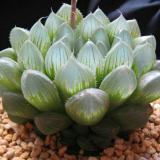
泥炭4 、赤玉土4、 植金石4、仙土3、(仙土2+松鳞)
桐生砂2、颗粒泥炭1、火山岩1、稻壳碳1
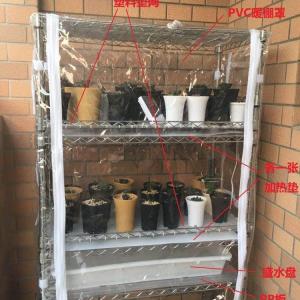
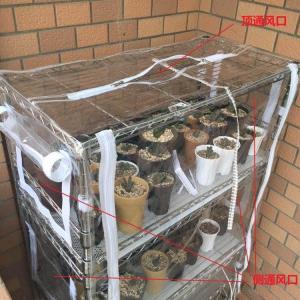
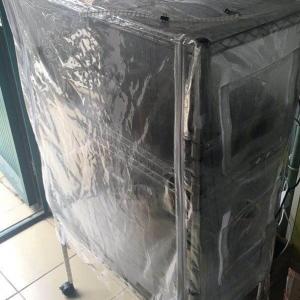
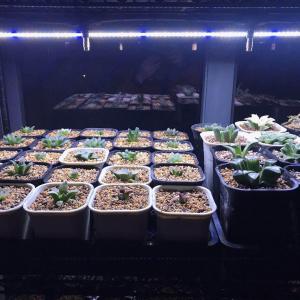
桐生砂2、颗粒泥炭1、火山岩1、稻壳碳1




2
1
攀雲樓 趙春:@lrgarden 这是养十二卷的
lrgarden:好多👍
文章
Miss Chen
2018年01月30日

Description: This herbaceous perennial plant consists of a loose rosette of 2-5 ascending basal leaves, from which a flowering stalk develops. The basal leaves are 4-12" long and 2-5 mm. across; they are medium green, hairless, linear in shape, and somewhat truncate at their tips. Leaf venation is parallel. The flowering stalk is 6-16" tall and more or less erect; it is medium green, hairless, terete (circular in cross-section), and hollow. This stalk terminates in a simple umbel of flowers about ¾–1¼" across, consisting of 4-8 flowers and their pedicels. The umbel has a short obconic shape, and it is more or less flat-headed. Individual flowers are about ½" long and similarly across. Each flower has 6 tepals that are primarily white, 6 stamens, and a superior ovary with a single style. The interior base of the tepals is usually yellow, while the exterior of each tepal has a longitudinal vein that is often reddish or greenish. The tepals are elliptic or lanceolate-oblong in shape. The anthers of the stamens are bright yellow, while their filaments are white, pale yellow, or pale green. The pedicels are medium green, hairless, slender, and straight to slightly incurved; they are about ½–¾" long during the blooming period, but become up to 1½" long afterwards. At the base of the umbel of flowers, there is a pair of membranous bracts that are about ½" in length and lanceolate in shape; they eventually wither away. The blooming period occurs from mid-spring to late spring, while a second blooming period sometimes occurs during the autumn. There is no noticeable floral scent. Afterwards, the flowers are replaced by seed capsules. These capsules are 6-8 mm. long, globoid-obovoid and slightly 3-lobed in shape, and hairless. Immature capsules are green, while mature capsules become light tan, dividing into 3 parts to release their seeds. There are about 4-6 black seeds for each lobe of a divided capsule. The root system consists of a bulb about ½" across with fibrous roots below. The exterior of the bulb is brown and membranous, while the interior is white and fleshy. Both the foliage and bulb of this plant lack a noticeable garlic or onion aroma. Occasionally, basal offsets occur, creating clumps of clonal plants.
Cultivation: The preference is an open area with full or partial sunlight, moist to dry-mesic conditions, and a slightly acidic to alkaline soil containing rocky material or sand.
Range & Habitat: The native False Garlic (Nothoscordum bivalve) occurs occasionally in southern Illinois and rarely in central Illinois, while in the northern section of the state it is absent (see Distribution Map). This plant is found primarily in the southeastern United States and Southern Plains region of the country. Illinois lies along its northern range-limit. Habitats include upland prairies, hill prairies, sandy or silty riverbottom prairies, rocky glades (including limestone, dolomite, and chert glades), open upland woodlands, upland savannas, and thinly wooded bluffs. In Illinois, False Garlic is found in higher quality natural areas, where it probably benefits from occasional wildfires and other kinds of disturbance if it reduces competition from woody plants.
Faunal Associations: The nectar of the flowers attracts cuckoo bees (Nomada spp.), green metallic bees (Augochlorella spp.) and other Halictid bees, Andrenid bees (Andrena spp.), bee flies, and small to medium-sized butterflies. One of the Andrenid bees, Andrena nothoscordi, is a specialist pollinator (oligolege or monolege) of False Garlic (Nothoscordum bivalve). This bee and other small bees also collect pollen from the flowers. Syrphid flies may visit the flowers occasionally to feed on the pollen, but they are less effective at cross-pollination. White-tailed Deer have been observed to feed on the foliage of False Garlic in areas of south Texas with loam or clay-loam soil (Chamrad & Box, 1968), although some authors consider this plant to be poisonous (Pammel, 1911). There is also sophisticated archaeological evidence that prehistoric people, thousands of years ago, cooked the bulbs of this plant in rock ovens in east Texas (Short et al., 2015).
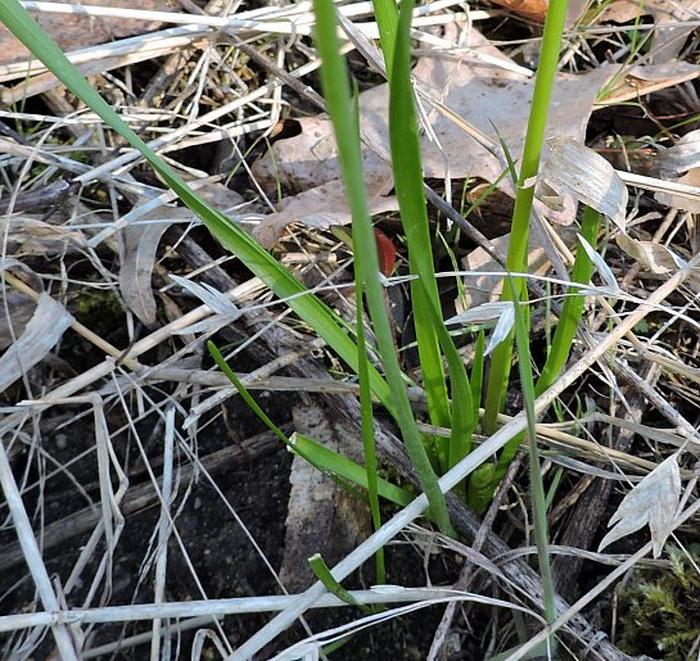
Photographic Location: A prairie at a nature preserve in Fayette County, Illinois. The photographs were taken by Keith & Patty Horn (Copyright © 2016).
Comments: False Garlic (Nothoscordum bivalve) resembles several other species in the Lily family (Liliaceae), especially native Allium spp. (Wild Garlic, etc.). This plant can be distinguished from this latter group of species by the lack of a noticeable garlic or onion aroma from its foliage and bulbs when they are rubbed or crushed. In addition, False Garlic never produces aerial bulblets in its inflorescence. Unlike many similar species in the Lily family, False Garlic has flowers with a yellow base and its basal leaves often have tips that are more truncate than rounded or pointed. Recently, the Lily family has been divided into several families of plants as a result of DNA analysis. Another common name of Nothoscordum bivalve is Crow Poison. The latter name suggests that this plant is poisonous, but the available evidence on this matter is contradictory.
Cultivation: The preference is an open area with full or partial sunlight, moist to dry-mesic conditions, and a slightly acidic to alkaline soil containing rocky material or sand.
Range & Habitat: The native False Garlic (Nothoscordum bivalve) occurs occasionally in southern Illinois and rarely in central Illinois, while in the northern section of the state it is absent (see Distribution Map). This plant is found primarily in the southeastern United States and Southern Plains region of the country. Illinois lies along its northern range-limit. Habitats include upland prairies, hill prairies, sandy or silty riverbottom prairies, rocky glades (including limestone, dolomite, and chert glades), open upland woodlands, upland savannas, and thinly wooded bluffs. In Illinois, False Garlic is found in higher quality natural areas, where it probably benefits from occasional wildfires and other kinds of disturbance if it reduces competition from woody plants.
Faunal Associations: The nectar of the flowers attracts cuckoo bees (Nomada spp.), green metallic bees (Augochlorella spp.) and other Halictid bees, Andrenid bees (Andrena spp.), bee flies, and small to medium-sized butterflies. One of the Andrenid bees, Andrena nothoscordi, is a specialist pollinator (oligolege or monolege) of False Garlic (Nothoscordum bivalve). This bee and other small bees also collect pollen from the flowers. Syrphid flies may visit the flowers occasionally to feed on the pollen, but they are less effective at cross-pollination. White-tailed Deer have been observed to feed on the foliage of False Garlic in areas of south Texas with loam or clay-loam soil (Chamrad & Box, 1968), although some authors consider this plant to be poisonous (Pammel, 1911). There is also sophisticated archaeological evidence that prehistoric people, thousands of years ago, cooked the bulbs of this plant in rock ovens in east Texas (Short et al., 2015).

Photographic Location: A prairie at a nature preserve in Fayette County, Illinois. The photographs were taken by Keith & Patty Horn (Copyright © 2016).
Comments: False Garlic (Nothoscordum bivalve) resembles several other species in the Lily family (Liliaceae), especially native Allium spp. (Wild Garlic, etc.). This plant can be distinguished from this latter group of species by the lack of a noticeable garlic or onion aroma from its foliage and bulbs when they are rubbed or crushed. In addition, False Garlic never produces aerial bulblets in its inflorescence. Unlike many similar species in the Lily family, False Garlic has flowers with a yellow base and its basal leaves often have tips that are more truncate than rounded or pointed. Recently, the Lily family has been divided into several families of plants as a result of DNA analysis. Another common name of Nothoscordum bivalve is Crow Poison. The latter name suggests that this plant is poisonous, but the available evidence on this matter is contradictory.
0
0
文章
Miss Chen
2018年01月30日

Description: This perennial plant consists of a loose rosette of basal leaves up to 10" across. Each basal leaf is about 4-6" long and ¼" across, although occasionally a larger size is achieved. The basal leaves are semi-erect, linear in shape, and light to medium green; their margins are finely crisped and often downy white. There is a prominent central vein along the length of each basal leaf. From the center of each rosette, there develops one or more leafless stalks about 6-8" tall. These stalks are light green and terete; sometimes they have shallow vertical grooves. Both the basal leaves and flowering stalks are glabrous to slightly pubescent; they contain a white milky latex. Each stalk terminates in a single flowerhead that is about 1-2" across when it is fully open.
Each flowerhead consists of numerous spreading ray florets and no disk florets. The overlapping petaloid rays of each flowerhead are yellow to golden yellow and linear-oblong in shape; their tips are truncated and 5-toothed. The floral bracts (phyllaries) surrounding the base of each flowerhead are arranged in a single overlapping series, where they are appressed together. These bracts are light green, lanceolate in shape, glabrous, and membranous along their margins. The blooming period occurs from mid- to late spring and lasts about a month. A single plant may produce several flowerheads in succession. The achenes are bullet-shaped with tufts of white hair at their apices. They are distributed by the wind. The root system consists of a stout taproot that is quite large for the size of the plant. This plant spreads by reseeding itself.

Cultivation: The preference is full sun and dry conditions. The soil should be gritty in texture and well-drained, otherwise crown rot may infect the taproot and the plant will die. Taller and more aggressive plant species should be prevented from overcrowding this plant, which normally grows on rocky hilltops and slopes where there is scant ground vegetation.
Range & Habitat: The native Prairie Dandelion is a rare plant that occurs in the northern half of Illinois, especially in the NW quarter of the state (see Distribution Map). It is state-listed as an endangered species. Some local populations that have been observed in the past are probably extirpated as a result of habitat destruction. Illinois lies at the eastern limit of its distribution; the Prairie Dandelion is more common in states further to the west. Habitats include dry upland areas of prairies, hill prairies, and rocky slopes. This conservative species does not normally occur in disturbed areas.

Faunal Associations: Little is known about the floral-faunal relationships of this rare plant. Various kinds of bees (especially bumblebees) are undoubtedly the most important pollinators of the flowers, where they seek nectar and pollen. Moure & Hurd (1987) list a Halictid bee, Halictus rubicundus, as a floral visitor. A polyphagous aphid, Abstrusomyzus phloxae, feeds on the closely related Mountain Dandelions (Agoseris spp.) and probably Prairie Dandelion as well. Rabbits may eat the foliage, although I have not observed this. Early pioneers ate the roots as a source of emergency food, even though they were undoubtedly bitter-tasting.
Photographic Location: The webmaster's wildflower garden in Urbana, Illinois.

Comments: This is one of many species in the Chicory tribe of the Aster family that have dandelion-like flowerheads and foliage with a milky latex. The most familiar member of this group is the introduced Taraxacum officinale (Dandelion), which is a common lawn weed. The Prairie Dandelion can be distinguished from similar species by considering the following characteristics: 1) this is a perennial plant, rather than a biennial or annual, 2) stems with cauline leaves are never produced, 3) there is only one flowerhead per leafless stalk, 4) the flowerheads are at least 1" across, 5) the basal leaves are linear in shape, and 6) the margins of the leaves are usually finely crisped and/or downy white. Other members of the Chicory tribe in Illinois usually lack one or more of these features. The closely related Agoseris spp. (Mountain Dandelions) of the western states have many of these features, but their achenes are conspicuously constricted below their apices. The achenes of the Prairie Dandelion are unconstricted or only slightly constricted below their apices. Other scientific names are occasionally used to refer to the Prairie Dandelion, including Agoseris cuspidata and Microseris cuspidata.
Each flowerhead consists of numerous spreading ray florets and no disk florets. The overlapping petaloid rays of each flowerhead are yellow to golden yellow and linear-oblong in shape; their tips are truncated and 5-toothed. The floral bracts (phyllaries) surrounding the base of each flowerhead are arranged in a single overlapping series, where they are appressed together. These bracts are light green, lanceolate in shape, glabrous, and membranous along their margins. The blooming period occurs from mid- to late spring and lasts about a month. A single plant may produce several flowerheads in succession. The achenes are bullet-shaped with tufts of white hair at their apices. They are distributed by the wind. The root system consists of a stout taproot that is quite large for the size of the plant. This plant spreads by reseeding itself.

Cultivation: The preference is full sun and dry conditions. The soil should be gritty in texture and well-drained, otherwise crown rot may infect the taproot and the plant will die. Taller and more aggressive plant species should be prevented from overcrowding this plant, which normally grows on rocky hilltops and slopes where there is scant ground vegetation.
Range & Habitat: The native Prairie Dandelion is a rare plant that occurs in the northern half of Illinois, especially in the NW quarter of the state (see Distribution Map). It is state-listed as an endangered species. Some local populations that have been observed in the past are probably extirpated as a result of habitat destruction. Illinois lies at the eastern limit of its distribution; the Prairie Dandelion is more common in states further to the west. Habitats include dry upland areas of prairies, hill prairies, and rocky slopes. This conservative species does not normally occur in disturbed areas.

Faunal Associations: Little is known about the floral-faunal relationships of this rare plant. Various kinds of bees (especially bumblebees) are undoubtedly the most important pollinators of the flowers, where they seek nectar and pollen. Moure & Hurd (1987) list a Halictid bee, Halictus rubicundus, as a floral visitor. A polyphagous aphid, Abstrusomyzus phloxae, feeds on the closely related Mountain Dandelions (Agoseris spp.) and probably Prairie Dandelion as well. Rabbits may eat the foliage, although I have not observed this. Early pioneers ate the roots as a source of emergency food, even though they were undoubtedly bitter-tasting.
Photographic Location: The webmaster's wildflower garden in Urbana, Illinois.

Comments: This is one of many species in the Chicory tribe of the Aster family that have dandelion-like flowerheads and foliage with a milky latex. The most familiar member of this group is the introduced Taraxacum officinale (Dandelion), which is a common lawn weed. The Prairie Dandelion can be distinguished from similar species by considering the following characteristics: 1) this is a perennial plant, rather than a biennial or annual, 2) stems with cauline leaves are never produced, 3) there is only one flowerhead per leafless stalk, 4) the flowerheads are at least 1" across, 5) the basal leaves are linear in shape, and 6) the margins of the leaves are usually finely crisped and/or downy white. Other members of the Chicory tribe in Illinois usually lack one or more of these features. The closely related Agoseris spp. (Mountain Dandelions) of the western states have many of these features, but their achenes are conspicuously constricted below their apices. The achenes of the Prairie Dandelion are unconstricted or only slightly constricted below their apices. Other scientific names are occasionally used to refer to the Prairie Dandelion, including Agoseris cuspidata and Microseris cuspidata.
0
0
文章
Miss Chen
2018年01月29日

Description: This herbaceous perennial plant is 2½–4' tall, branching frequently in the upper half. The light green stems are four-angled and hairless. The opposite leaves are broadly lanceolate to ovate, and vary in color from light green to dark green, sometimes with yellow or red tints. These color variations are in part a response to environmental conditions. The hairless leaves are up to 4" long and 2" across, and have serrated margins. They exude an oregano scent. At the top of major stems are rounded heads of flowers about 1-3" across. The flowers begin blooming in the center of the head, gradually moving toward its periphery, forming a wreath of flowers. Each flower is lavender or pink, and about 1" long, with an irregular shape. The corolla divides into a tubular upper lip with projecting stamens, and three slender lower lips that function as landing pads for visiting insects. The blooming period occurs during mid-summer and lasts about 1 month. The root system consists of deep, strongly branched roots, and shallow rhizomes that are responsible for the vegetative spread of the plant. These rhizomes typically send up multiple leafy stems in a tight cluster, giving Wild Bergamot a bushy appearance.
Cultivation: The preference is full or partial sun, and moist to slightly dry conditions. Growth is more luxuriant in a moist rich loam, although this can cause the plant to flop around as the growing season progresses. Under drought conditions, the lower leaves will turn yellow and drop off the stems; this reaction is normal. The lower leaves often develop powdery mildew, particularly when the weather is rainy. While this plant is easy to grow, it often becomes rather dilapidated in appearance as the growing season progresses because of these problems. This plant often spreads aggressively.
Range & Habitat: The native Wild Bergamot occurs throughout Illinois, except for a few southern counties within the state (see Distribution Map). It is occasional to locally common. Habitats include moist to slightly dry black soil prairies, hill prairies, sandy Black Oak woodlands, savannas and woodland borders, thickets, borders of limestone glades, abandoned pastures, and landfills. The rhizomes can survive earth-moving and bulldozing operations, and send up plants in unexpected places. Some local populations may be plants that have escaped cultivation.

Faunal Associations: The nectar of the flowers attracts long-tongued bees, bee flies, butterflies, skippers, and hummingbird moths. Among the long-tongued bees, are such visitors as bumblebees, Miner bees, Epeoline Cuckoo bees, and large Leaf-Cutting bees. A small black bee (Dufourea monardae) specializes in the pollination of Monarda flowers. Sometimes Halictid bees collect pollen, while some wasps steal nectar by perforating the nectar tube. The Ruby-Throated Hummingbird also visits the flowers. The caterpillars of the moths Sphinx eremitus (Hermit Sphinx) and Agriopodes teratophora (Gray Marvel) feed on the foliage. A seed bug (Ortholomus scolopax) is sometimes found in the flowerheads. Mammalian herbivores usually avoid this plant as a food source, probably because of the oregano-mint flavor of the leaves and their capacity to cause indigestion; they may contain chemicals that disrupt populations of beneficial bacteria in the digestive tract.

Photographic Location: Photographs were taken at Meadowbrook Park in Urbana, Illinois.
Comments: For a member of the mint family, the flowers are large and beautiful. Wild Bergamot can be distinguished from other Monarda spp. by the color of its flowers – the corollas of its flowers are solid pink or lavender. Other species have flowers with red, purple, or white corollas, or they have dark purple dots on the lower lips of their corollas.
Cultivation: The preference is full or partial sun, and moist to slightly dry conditions. Growth is more luxuriant in a moist rich loam, although this can cause the plant to flop around as the growing season progresses. Under drought conditions, the lower leaves will turn yellow and drop off the stems; this reaction is normal. The lower leaves often develop powdery mildew, particularly when the weather is rainy. While this plant is easy to grow, it often becomes rather dilapidated in appearance as the growing season progresses because of these problems. This plant often spreads aggressively.
Range & Habitat: The native Wild Bergamot occurs throughout Illinois, except for a few southern counties within the state (see Distribution Map). It is occasional to locally common. Habitats include moist to slightly dry black soil prairies, hill prairies, sandy Black Oak woodlands, savannas and woodland borders, thickets, borders of limestone glades, abandoned pastures, and landfills. The rhizomes can survive earth-moving and bulldozing operations, and send up plants in unexpected places. Some local populations may be plants that have escaped cultivation.

Faunal Associations: The nectar of the flowers attracts long-tongued bees, bee flies, butterflies, skippers, and hummingbird moths. Among the long-tongued bees, are such visitors as bumblebees, Miner bees, Epeoline Cuckoo bees, and large Leaf-Cutting bees. A small black bee (Dufourea monardae) specializes in the pollination of Monarda flowers. Sometimes Halictid bees collect pollen, while some wasps steal nectar by perforating the nectar tube. The Ruby-Throated Hummingbird also visits the flowers. The caterpillars of the moths Sphinx eremitus (Hermit Sphinx) and Agriopodes teratophora (Gray Marvel) feed on the foliage. A seed bug (Ortholomus scolopax) is sometimes found in the flowerheads. Mammalian herbivores usually avoid this plant as a food source, probably because of the oregano-mint flavor of the leaves and their capacity to cause indigestion; they may contain chemicals that disrupt populations of beneficial bacteria in the digestive tract.

Photographic Location: Photographs were taken at Meadowbrook Park in Urbana, Illinois.
Comments: For a member of the mint family, the flowers are large and beautiful. Wild Bergamot can be distinguished from other Monarda spp. by the color of its flowers – the corollas of its flowers are solid pink or lavender. Other species have flowers with red, purple, or white corollas, or they have dark purple dots on the lower lips of their corollas.
0
0
文章
Miss Chen
2018年01月29日

Description: This herbaceous perennial plant is about 2-4' tall, branching occasionally. The stems are glabrous and light green; they are often angular below, becoming more round above. The dark green opposite leaves are up to 4" long and 3" across. They are cordate (somewhat triangular-shaped) and hairless, with smooth margins and short petioles. Some of the upper leaves near the flowers are much smaller and lanceolate. The upper stems terminate in clusters of magenta flowers on long stalks. Usually, there are a few hairs on these stalks and the pedicels of the flower clusters. A cluster of 3-5 flowers develop within a surrounding green bract with 5 lobes; this bract has the appearance of a calyx. These flowers are trumpet-shaped and span about ½" across, or slightly less. There are no petals; instead, a tubular calyx with 5 notched lobes functions as a corolla. At the center of each flower are 3-5 exerted stamens with yellow anthers. The blooming period is usually during the early summer and lasts about a month. There is little or no floral fragrance. The flowers typically open during the late afternoon, remain open at night, and close during the morning. The greyish brown seed is up to 3/8" (10 mm.) long and pubescent; it has 5 ribs. The root system consists of a thick dark taproot that is fleshy or woody. This plant spreads by reseeding itself.
Cultivation: The preference is full sun and mesic to dry conditions; partial sun is also tolerated. This plant commonly grows in poor soil that has a high content of clay, sand, or gravelly material. It will also grow in fertile loam, but suffers from the competition of neighboring plants. Foliar disease is not usually troublesome. It is easy to start plants from seeds.
Range & Habitat: Wild Four-O'Clock occurs in nearly every county of Illinois; it is a common plant (see Distribution Map). This plant is adventive from areas that lie west of of the state. Habitats include dry prairies, pastures, abandoned fields, grassy roadsides, rocky banks along ditches, areas along railroads (including the ballast), and miscellaneous waste areas. This plant is particularly common along railroads. It has a strong preference for disturbed areas.

Faunal Associations: The flowers are visited primarily by long-tongued bees, short-tongued bees, and moths. These insects seek nectar primarily, although the short-tongued bees collect pollen. It is possible that the Ruby-Throated hummingbird may visit the flowers as well. The species Catorhintha mendica (Wild Four-O'Clock Bug) is a specialist feeder on this plant and other Mirabilis spp. Another specialist is Heliodines nyctaginella (Four-O'Clock Moth); the caterpillars of this species feed on the foliage of this and other plants in the genus. Wild Four-O'Clock tends to increase in areas disturbed by livestock; it is unclear if these animals eat this plant. Deer reportedly avoid it. The seeds and roots are known to be poisonous, although pigs may dig up the roots and eat them.

Photographic Location: The photographs were taken along a railroad track in Champaign-Urbana, Illinois.
Comments: This is the most widespread Four-O'Clock species in Illinois that is from North America. The commonly cultivated garden plant by the same name is from South America; it is non-hardy. There are a few wild Mirabilis spp. in the Chicago area that are adventive from the west. They usually have more narrow leaves, hairier stems, and flowers with paler colors. In some of the Great Plains states, the Wild Four-O'Clock can have pale yellow flowers, but this color form doesn't appear to occur in Illinois.
Cultivation: The preference is full sun and mesic to dry conditions; partial sun is also tolerated. This plant commonly grows in poor soil that has a high content of clay, sand, or gravelly material. It will also grow in fertile loam, but suffers from the competition of neighboring plants. Foliar disease is not usually troublesome. It is easy to start plants from seeds.
Range & Habitat: Wild Four-O'Clock occurs in nearly every county of Illinois; it is a common plant (see Distribution Map). This plant is adventive from areas that lie west of of the state. Habitats include dry prairies, pastures, abandoned fields, grassy roadsides, rocky banks along ditches, areas along railroads (including the ballast), and miscellaneous waste areas. This plant is particularly common along railroads. It has a strong preference for disturbed areas.

Faunal Associations: The flowers are visited primarily by long-tongued bees, short-tongued bees, and moths. These insects seek nectar primarily, although the short-tongued bees collect pollen. It is possible that the Ruby-Throated hummingbird may visit the flowers as well. The species Catorhintha mendica (Wild Four-O'Clock Bug) is a specialist feeder on this plant and other Mirabilis spp. Another specialist is Heliodines nyctaginella (Four-O'Clock Moth); the caterpillars of this species feed on the foliage of this and other plants in the genus. Wild Four-O'Clock tends to increase in areas disturbed by livestock; it is unclear if these animals eat this plant. Deer reportedly avoid it. The seeds and roots are known to be poisonous, although pigs may dig up the roots and eat them.

Photographic Location: The photographs were taken along a railroad track in Champaign-Urbana, Illinois.
Comments: This is the most widespread Four-O'Clock species in Illinois that is from North America. The commonly cultivated garden plant by the same name is from South America; it is non-hardy. There are a few wild Mirabilis spp. in the Chicago area that are adventive from the west. They usually have more narrow leaves, hairier stems, and flowers with paler colors. In some of the Great Plains states, the Wild Four-O'Clock can have pale yellow flowers, but this color form doesn't appear to occur in Illinois.
0
0
文章
Miss Chen
2018年01月22日

Description: This herbaceous perennial plant is 1-2' tall and more or less erect. Initially, it consists of a rosette of leaves that are rather angular and orbicular. Later, a central stem develops that is 4-angled and smooth. The opposite leaves are up to 5" long and ¾" across. They are lanceolate or narrowly ovate, and often fold upward along the length of the central vein. Their margins are usually smooth (although sometimes ciliate), and there are no hairs, except toward the base of each leaf. These leaves are sessile against the stem, or they have short petioles with a few coarse hairs. The uppermost leaves at the top of a plant are usually whorled. The underside of each leaf is light or whitish green, but eventually becomes darker with age. There are a few short side stems in the upper half of the plant. From 1-4 nodding flowers develop from the upper axils of the leaves, each with its own pedicel. Each flower is about ¾" across, with 5 narrowly triangular green sepals, 5 yellow petals, and 5 yellowish orange stamens. The petals are well-rounded, but their outer edges are often ragged and may have conspicuous tips. Toward the center of the flower, there is a patch of orange surrounding the upper portion of the pistil. The blooming period occurs from early to mid-summer and lasts about a month. There is no noticeable fragrance. The flowers are replaced by spheroid capsules with slender spike-like tips. A fully developed capsule is about the same heighth as the surrounding sepals. The root system consists of a taproot and rhizomes that form little plantlets. This plant often forms small colonies by means of vegetative reproduction.

Cultivation: The preference is partial to full sun, and moist to mesic conditions. This plant usually grows in a loam or clay-loam soil, but it can tolerate soil with sandy or rocky material as well. The foliage is rarely bothered by disease; occasionally insects nibble the edges of the leaves.
Range & Habitat: The native Lance-Leaved Loosestrife occurs in most areas of Illinois, except for a few north-central counties and scattered counties elsewhere (see Distribution Map). Although widely distributed, it is an occasional plant. Habitats include moist to mesic black soil prairies, open woodlands, thickets, swamps, gravelly seeps, limestone glades, and old fields with hardpan clay or sandy soil.
Faunal Associations: The flowers of the Lysimachia spp. (Yellow-Flowered Loosestrifes) are unusual in that they produce a floral oil, rather than nectar. Because of this, they attract the short-tongued Melittid bee, Macropsis steironematis. This oligolectic bee collects both the floral oil and pollen and forms a pollen-ball that becomes the food of its developing bee-larvae. Otherwise, the flowers attract few insects, except for the occasional visitor seeking pollen from the anthers. Information about Lance-Leaved Loosestrife's relation to birds and mammals does not appear to be readily accessible at the present time.
Photographic Location: The photographs were taken at the Prospect Cemetery Prairie in Ford County, Illinois, where there was a small colony of plants growing in mesic black soil prairie.
Comments: This plant would be more attractive to humans if the flowers did not hang downward. The nodding characteristic of some flowers is often a sign that the primary pollinators are bees, which are more willing to hang upside down on the protruding structures of a flower in order to obtain whatever food source they are seeking. This characteristic may also protect the nectar or floral oil from rainfall. Lance-Leaved Loosestrife can be distinguished from other loosestrifes primarily by its opposite leaves, which are sessile or have very short petioles. The height of the mature seed capsules is about the same as the height of the surrounding calyx segments, while in other Lysimachia spp. they are often unequal. The species Lysimachia hybrida, which used to be considered a variety of Lance-Leaved Loosestrife, has a similar appearance. However, Lysimachia hybrida is supposed to have somewhat longer petioles, somewhat broader leaves, and the undersides of its leaves are green rather than light or whitish green, even in younger leaves.

Cultivation: The preference is partial to full sun, and moist to mesic conditions. This plant usually grows in a loam or clay-loam soil, but it can tolerate soil with sandy or rocky material as well. The foliage is rarely bothered by disease; occasionally insects nibble the edges of the leaves.
Range & Habitat: The native Lance-Leaved Loosestrife occurs in most areas of Illinois, except for a few north-central counties and scattered counties elsewhere (see Distribution Map). Although widely distributed, it is an occasional plant. Habitats include moist to mesic black soil prairies, open woodlands, thickets, swamps, gravelly seeps, limestone glades, and old fields with hardpan clay or sandy soil.
Faunal Associations: The flowers of the Lysimachia spp. (Yellow-Flowered Loosestrifes) are unusual in that they produce a floral oil, rather than nectar. Because of this, they attract the short-tongued Melittid bee, Macropsis steironematis. This oligolectic bee collects both the floral oil and pollen and forms a pollen-ball that becomes the food of its developing bee-larvae. Otherwise, the flowers attract few insects, except for the occasional visitor seeking pollen from the anthers. Information about Lance-Leaved Loosestrife's relation to birds and mammals does not appear to be readily accessible at the present time.
Photographic Location: The photographs were taken at the Prospect Cemetery Prairie in Ford County, Illinois, where there was a small colony of plants growing in mesic black soil prairie.
Comments: This plant would be more attractive to humans if the flowers did not hang downward. The nodding characteristic of some flowers is often a sign that the primary pollinators are bees, which are more willing to hang upside down on the protruding structures of a flower in order to obtain whatever food source they are seeking. This characteristic may also protect the nectar or floral oil from rainfall. Lance-Leaved Loosestrife can be distinguished from other loosestrifes primarily by its opposite leaves, which are sessile or have very short petioles. The height of the mature seed capsules is about the same as the height of the surrounding calyx segments, while in other Lysimachia spp. they are often unequal. The species Lysimachia hybrida, which used to be considered a variety of Lance-Leaved Loosestrife, has a similar appearance. However, Lysimachia hybrida is supposed to have somewhat longer petioles, somewhat broader leaves, and the undersides of its leaves are green rather than light or whitish green, even in younger leaves.
0
0



